English
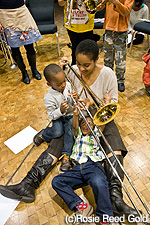
Come and Play!

This article reports two of the numerous events run by the Barbican/ Guildhall School Creative Learning: one is called 'Come and Play!', which focused on music and took place all over the Barbican Centre and the Guildhall School of Music and Drama, while the other is called 'Disruption', which involved a collaboration between various art genres.
Disruption video
Dates: Saturday 6th November 2010, Sunday 7th November, 10:00-17:00
Venue: Barbican Centre, (Silk Street London, EC2Y 8DS), Guildhall School of Music & Drama, (Silk Street, Barbican, EC2Y 8DT) [Map]
Date: Saturday 29th January, 18:00-19:30
Venue: Barbican Centre, Free Stage in the foyer, Club Stage on the lower ground floor
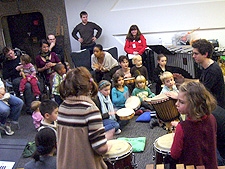
Percussion workshop
'Come and Play!' took place over a weekend utilizing the space at the Barbican Centre and the Guildhall School of Music and Drama. It was one of the biggest events focused especially on music run by the Barbican/Guildhall School Creative Learning. Discribed as aiming to 'offer access to art for everyone' by Anne, the Music and Cross Arts Producer of Creative Learning (See No. 2), they opened their space to the public to enjoy many free or low-cost workshops, including its halls, cinemas, free stages and the open spaces on the lower ground, ground and mezzanine floors at the Barbican on the Saturday, and some of the rooms at the Guildhall School on the Sunday.
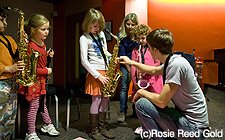
Jazz workshop
The target was members of the public of all ages. Most of the events at the Barbican were drop-in musical activities for children and families, with little or no experience of music, and there was a free music stage for everyone, while the events at the Guildhall School targeted young people who wanted or had just started to learn to play some musical instrument, and adults who had had some experience in the past and wanted to start it again. Over the weekend, 3000 people attended the event: 2000 visited the Barbican on Saturday, and 1000 visited the Guildhall School on Sunday.
On Saturday, the Barbican Centre was bustling, filled with families. When you entered the building, you could see an installation of objects hanging on the wall, pretending to be 'musical notes' on a musical score. Then, you saw families making their own musical instruments from lots of colorful materials on the lower ground floor, and heard the sound of saxophones and clarinets that the young people were playing on the upper floor. The centre was divided into four themes on that day: Have A Go, Make Zone, Explore, and Watch And Listen.
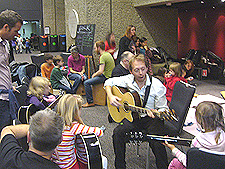
Folk music workshop
In the 'Have A Go' section, there were five free workshops that enabled beginners to try out musical instruments. They could use the instruments provided or bring their own. Families with children over three years old could try out different genres of music; for example, they could play classical music on a violin, cello or trumpet, rock music on a guitar, folk music on a banjo, percussion music on a tambourine and jambe; jazz on a saxophone and clarinet, etc. The group workshops were repeated several times between 10am and 4pm and were free, but needed to be booked. In the banjo playing group, the children sat in a circle with the instructor and learnt how to hold and play the instrument. The percussion group was popular with the small children. They sat on a cushion and played drums and tambourines, watching the instructor play different rhythms.
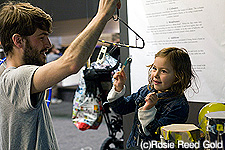
Make your own instrument
In the 'Make Zone', the children could make their own musical instruments and find out how the sound is made. There were three instrument-making workshops that day; Percussion Buffet, oboe making, and guitar making. People could book a space with a material fee of 2 pounds each. In the Percussion Buffet, children could choose different shapes and sizes of materials to make a drum from a buffet table, which provided 'frames', 'membranes', 'cylinders', 'contact implements', and 'additions' for adding special effects to the instrument. This unique workshop provided families with an opportunity to make their own instruments by choosing any materials they liked, and taking them home with them. The two workshops on making a guitar out of cardboard and making an oboe out of straws were popular among older children.
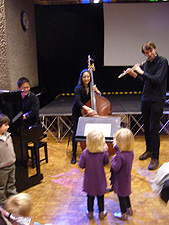
Conduct a trio
The 'Explore' section was devised by current and former Guildhall School students, and provided a chance to explore different ways of creating music. In the 'Play Me' corner, children could experience creating music by conducting the musicians and using technology; for example, there was a trio who improvised music in response to the child conductor who conducted them by pointing to the instruments and moving their body. There was also a marimba musician who played a piece following the card a child showed, saying, 'crescendo', 'accelerando', etc. They could even move a musician's hand up and down, left to right, to create music with an electric musical instrument called a Theremin. 'Cast Your Note' was an avant-garde attempt, where people passing by the entrance of the building could hang objects, such as paper cups and wool yarn, from strings on the wall like a decoration and, from time to time, a band of musicians appeared and created music by interpreting the installation as a music score.
In the 'Watch and Listen' section, there were jazz, folk and percussion concerts on the Free Stage in the foyer, where people could enjoy the music with a cup of tea. In the cinema, families sang along to the film 'Beauty and the Beast', and played along to a silent movie with musical instruments that they had brought or just made in the 'Make Zone'.
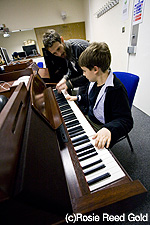
Piano experience at the Guildhall School
On Sunday, there were some free music workshops at the Guildhall School. Group workshops on folk, rock, percussion music, piano, and choir music were run for young people aged over 8 years old and adults of any ability, from people who were practicing the instruments, to those who had not played it for a long time, to people who just wanted to try them. This helped the participants to find a way to enjoy not only playing an instrument but also playing ensemble music alongside other players, and creating music without reading a music score.
In addition to these workshops and concerts, advice was offered throughout the weekend on how to continue your music journey by arts organizations such as Arts Council England, Sound Connections, Making Music, and the Federation of Music Services. This reflected the intention of Creative Learning for people to extend their passion at the end of the day.
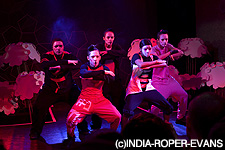
Disruption performance
The other event I observed was called 'Disruption', a unique event uniting music and fashion. It was part of a series of events which had been taking place in association with the fashion exhibition, 'Future Beauty: 30 Years of Japanese Fashion', which had been held since October 2010 until February 2011 at the Barbican Art Gallery. At the Japanese fashion exhibition, stimulating garments designed by leading Japanese fashion designers since the 1980s to the present were exhibited. Alongside the exhibition, around 30 related events about fashion and Japanese culture took place during this period; for example, talks, workshops, classes, film screenings, and a theatrical performance. 'Disruption' had been in preparation throughout this period and the fashion show was performed as its culmination. It uniquely blended the various genres of art that the Barbican can offer.
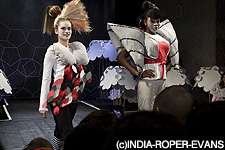
The project launched in September 2010. 50 students participated in the project from East London secondary schools, which was the main target area of Creative Learning, and the schoolteachers and staff at Creative Learning attended project meetings together. The students and teachers visited the exhibition at the art gallery in October, and the workshops started in November, based on their impressions and ideas that they had written down in their sketchbooks.
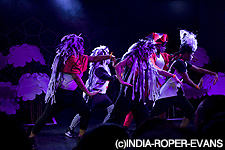
During eight weeks of workshops, teachers at the London College of Fashion practically taught the students costume design, headwear and accessory design, garment making, styling, filming and photography for two hours every Tuesday evening at the college. The ideas that the students took from the exhibition and reflected in the garment design were a 'black, white and red' pallet and 'volume' for headwear and accessories. The theme was to mix East London fashion with Eastern fashion and present an urban hybrid.
In parallel, Future Band, consisting of young musicians aged 9 to 16 years old, also visited the fashion exhibition and started to create music inspired by it together with the Guildhall school leaders. The way of music making was basically the same as for Guildhall Connect (see 'Connect No. 3'). The ideas that the young people took from Japanese fashion were 'shade', 'space' and 'to fold'.
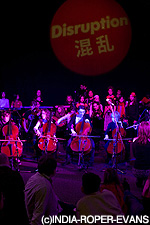 Future Band
Future BandThe performance was not planned like an ordinary fashion show - just to parade on the catwalk in costume- but to show costume in a unique style with dance and music. The dance for the performance was created by a dance group of 13 to 18 year olds, called Blue Boys, with the help of a professional choreographer.
The music for the performance was composed by Jo Wills who had led the Guildhall Connect, and was inspired by Japan, including Japanese fashion. The headwear design and make-up was undertaken by professional designers from the Tony & Guy salon and Shiseido make-up, who visited the schools to see images of the costumes. Furthermore, the stage design and light design for the performance were awarded as a prize in an architecture competition and realized on the day of the performance.
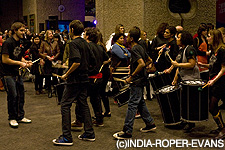
Drums leading the audience
On the day of the performance, 29th January, Future Band performed their original music inspired by the Japanese exhibition on Free Stage in the foyer for 30 minutes from 18:30. When the music performance finished, Joe and a drum band led the audience to the fashion show stage on the lower ground floor, while drumming. The fashion show took place on a stage that had been specially designed for the performance, with dancers wearing costumes that the young people had designed, dancing to original choreography for 30 minutes, accompanied by original music and lights. The students stood around the stage and were excited to see their costumes presented in a unique and exciting way.

Thus, the performance was a culmination of various aspects of art experience - the visit to the fashion exhibition, costume design, garment making, music making, dance choreography, film, dance performance, architecture, light design, and attending a performance as an audience. This project was made possible through the collaboration between the Barbican, the Guildhall School, the London College of Fashion, individual artists and groups, the community and companies. In other words, this project created a new style of collaboration and showed the future possibility of art.
Report: Chigusa Futako








